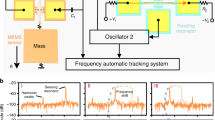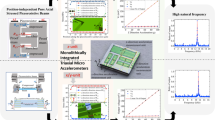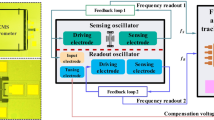Abstract
Exceptional points (EP) are non-Hermitian degeneracies where eigenvalues and their corresponding eigenvectors coalesce1,2,3,4. Recently, EPs have attracted attention as a means to enhance the responsivity of sensors, through the abrupt resonant detuning occurring in their proximity5,6,7,8,9,10,11,12,13,14,15,16,17,18,19,20. In many cases, however, the EP implementation is accompanied by noise enhancement, leading to the degradation of the sensor’s performance15,16,17,18,19,20. The excess noise can be of fundamental nature (owing to the eigenbasis collapse) or of technical nature associated with the amplification mechanisms utilized for the realization of EPs. Here we show, using an EP-based parity–time symmetric21,22 electromechanical accelerometer, that the enhanced technical noise can be surpassed by the enhanced responsivity to applied accelerations. The noise owing to eigenbasis collapse is mitigated by exploiting the detuning from a transmission peak degeneracy (TPD) — which forms when the sensor is weakly coupled to transmission lines — as a measure of the sensitivity. These TPDs occur at a frequency and control parameters for which the biorthogonal eigenbasis is still complete and are distinct from the EPs of the parity–time symmetric sensor. Our device shows a threefold signal-to-noise-ratio enhancement compared with configurations for which the system operates away from the TPD.
This is a preview of subscription content, access via your institution
Access options
Access Nature and 54 other Nature Portfolio journals
Get Nature+, our best-value online-access subscription
$29.99 / 30 days
cancel any time
Subscribe to this journal
Receive 51 print issues and online access
$199.00 per year
only $3.90 per issue
Buy this article
- Purchase on Springer Link
- Instant access to full article PDF
Prices may be subject to local taxes which are calculated during checkout



Similar content being viewed by others
Data availability
The datasets generated during and/or analysed during the current study are available in the Zenodo repository at https://doi.org/10.5281/zenodo.6397748.
Change history
09 March 2023
A Correction to this paper has been published: https://doi.org/10.1038/s41586-023-05890-3
References
Kato, T. Perturbation Theory for Linear Operators (Springer, 2013).
Berry, M. V. Physics of nonhermitian degeneracies. Czech. J. Phys. 54, 1039–1047 (2004).
Miri, M.-A. & Alu, A. Exceptional points in optics and photonics. Science 363, eaar7709 (2019).
Parto, M., Liu, Y. G. N., Bahari, B., Khajavikhan, M. & Christodoulides, D. N. Non-Hermitian and topological photonics: optics at an exceptional point. Nanophotonics 10, 403 (2021).
Wiersig, J. Enhancing the sensitivity of frequency and energy splitting detection by using exceptional points: application to microcavity sensors for single-particle detection. Phys. Rev. Lett. 112, 203901 (2014).
Hodaei, H. et al. Enhanced sensitivity at higher-order exceptional points. Nature 548, 187–191 (2017).
Chen, W., Ozdemir, S. K., Zhao, G., Wiersig, J. & Yang, L. Exceptional points enhance sensing in an optical microcavity. Nature 548, 192–196 (2017).
Chen, P.-Y. et al. Generalized parity–time symmetry condition for enhanced sensor telemetry. Nat. Electron. 1, 297–304 (2018).
Dong, Z., Li, Z., Yang, F., Qiu, C.-W. & Ho, J. S. Sensitive readout of implantable microsensors using a wireless system locked to an exceptional point. Nat. Electron. 2, 335–342 (2019).
Hokmabadi, M. P., Schumer, A., Christodoulides, D. N. & Khajavikhan, M. Non-Hermitian ring laser gyroscopes with enhanced Sagnac sensitivity. Nature 576, 70–74 (2019).
Kononchuk, R. & Kottos, T. Orientation-sensed optomechanical acelerometers based on exceptional points. Phys. Rev. Res. 2, 023252 (2020).
Park, J.-H. et al. Symmetry-breaking-induced plasmonic exceptional points and nanoscale sensing. Nat. Phys. 16, 462–468 (2020).
Xiao, Z., Li, H., Kottos, T. & Alú, A. Enhanced sensing and nondegrated thermal noise performance based on \({\mathscr{P}}{\mathscr{T}}\)-symmetric electronic circuits with a sixth-order exceptional point. Phys. Rev. Lett. 123, 213901 (2019).
Zhang, M. et al. Quantum noise theory of exceptional point amplifying sensors. Phys. Rev. Lett. 123, 180501 (2019).
Lau, H.-K. & Clerk, A. A. Fundamental limits and non-reciprocal approaches in non-Hermitian quantum sensing. Nat. Commun. 9, 4320 (2018).
Wiersig, J. Prospects and fundamental limits in exceptional point-based sensing. Nat. Commun. 11, 2454 (2020).
Lai, Y.-H., Lu, Y.-K., Suh, M.-G., Yuan, Z. & Vahala, K. Observation of the exceptional-point-enhanced Sagnac effect. Nature 576, 65–69 (2019).
Wang, H., Lai, Y.-H., Yuan, Z., Suh, M.-G. & Vahala, K. Petermann-factor sensitivity limit near an exceptional point in a Brillouin ring laser gyroscope. Nat. Commun. 11, 1610 (2020).
Langbein, W. No exceptional precision of exceptional-point sensors. Phys. Rev. A 98, 023805 (2018).
Wiersig, J. Robustness of exceptional point-based sensors against parametric noise: the role of Hamiltonian and Liouvillian degeneracies. Phys. Rev. A 101, 053846 (2020).
Schindler, J. et al. PT-symmetric electronics. J. Phys. A 45, 444029 (2012).
Bender, C. M. & Böttcher, S. Real spectra in non-Hermitian Hamiltonians having \({\mathscr{P}}{\mathscr{T}}\) symmetry. Phys. Rev. Lett. 80, 5243 (1998).
Fraden, J. in Handbook of Modern Sensors, Chapter 2 (Springer, 2016).
Xiao, G. & Bock, W. J. Photonic Sensing: Principles and Applications for Safety and Security Monitoring (Wiley Series in Microwave and Optical Engineering, Wiley, 2012).
Bao, M. Micro Mechanical Transducers: Pressure Sensors, Accelerometers and Gyroscopes (Elsevier, 2000).
De Brito Andre, P. S. & Humberto, V. Accelerometers: Principles, Structure and Applications (Nova Science, 2013).
Wen, H. et al. Slow-light fiber-Bragg-grating strain sensor with a 280-femtostrain/\(\sqrt{{\rm{Hz}}}\)} resolution. J. Light. Technol 31, 11 (2013).
Skolianos, G., Aurora, A., Bernier, M. & Digonnet, M. J. Slow light in Bragg gratings and its applications. J. Phys. D 49, 463001 (2016).
Geng, Q. & Zhu, K.-D. Discrepancy between transmission spectrum splitting and eigenvalue splitting: a reexamination on exceptional point-based sensors. Photon. Res. 9, 1645–1649 (2021).
Sweeney, W. R., Hsu, C. W., Rotter, S. & Stone, A. D. Perfectly absorbing exceptional points and chiral absorbers. Phys. Rev. Lett. 122, 093901 (2019).
Sweeney, W. R., Hsu, C. W. & Stone, A. D. Theory of reflectionless scattering modes. Phys. Rev. A 102, 063511 (2020).
Yoo, G., Sim, H.-S. & Schomerus, H. Quantum noise and mode nonorthogonality in non-Hermitian \({\mathscr{P}}{\mathscr{T}}\) -symmetric optical resonators. Phys. Rev. A 84, 063833 (2011).
Krause, A. G., Winger, M. T., Blasius, D., Lin, Q. & Painter, O. A high-resolution microchip optomechanical accelerometer. Nat. Photon. 6, 768–772 (2012).
Li, Y. L. & Barker, P. F. Characterization and testing of a micro-g whispering gallery mode optomechanical accelerometer. J. Light. Technol. 36, 3919–3926 (2018).
Regal, C. A., Teufel, J. D. & Lehnert, K. W. Measuring nanomechanical motion with a microwave cavity interferometer. Nat. Phys. 4, 555–560 (2008).
El-Sheimy, N., Hou, H. & Niu, X. Analysis and modeling of inertial sensors using Allan variance. IEEE Trans. Instrum. Meas. 57, 140–149 (2008).
Quinchia, A. G., Falco, G., Falletti, E., Dovis, F. & Ferrer, C. A comparison between different error modeling of MEMS applied to GPS/INS integrated systems. Sensors 13, 9549–9588 (2013).
Duggen, R., Mann, S. & Alú, A. Limitations of sensing at an exceptional point. ACS Photon. 9, 1554–1566 (2022).
Acknowledgements
We acknowledge partial support from NSF-CMMI-1925543, NSF-CMMI-1925530, ONR N00014-19-1-2480 and from a grant from Simons Foundation for Collaboration in MPS number 733698. R.T. and J.C. acknowledge the partial support for this research provided by the University of Wisconsin-Madison, Office of the Vice Chancellor for Research and Graduate Education with funding from the Wisconsin Alumni Research Foundation.
Author information
Authors and Affiliations
Contributions
R.K., J.C., F.E. and R.T. designed the mechanical device. R.K. and F.E. designed and fabricated the electronic circuit. J.C. and R.T. fabricated the mechanical device. R.K. performed the characterization and data processing of the accelerometer and developed the theory with the support of T.K. All authors discussed the results. T.K. conceived the project. R.K. and T.K. wrote the manuscript with input from all authors.
Corresponding author
Ethics declarations
Competing interests
The authors declare no competing interests.
Peer review
Peer review information
Nature thanks Jan Wiersig and the other, anonymous, reviewer(s) for their contribution to the peer review of this work. Peer reviewer reports are available.
Additional information
Publisher’s note Springer Nature remains neutral with regard to jurisdictional claims in published maps and institutional affiliations.
Extended data figures and tables
Extended Data Fig. 1 Schematic of the circuit diagram.
The dark grey large boxes indicate the ADA4862- 3 operational amplifiers, while the light grey box indicates the spring mass which provides the acceleration dependent capacitance \({C}_{{cv}}\).
Extended Data Fig. 2 Details of the mechanical sensor elements.
a,b, Drawings of the copper platform. c,d, Drawings of the test mass.
Extended Data Fig. 3 Assembly process of the acceleration capacitive sensor.
a, Deposition of the gold nanofilms on a glass substrate that create conductive electrodes which form the capac- itors plates. Attachment of the glass plates to the stationary platform and test mass. b, Placement of the test mass with glass plate on top of the copper base. c, Assembled capacitive inertial sensor. The inset shows the magnified view of the area between the capacitor plates which is about 20 m.
Supplementary information
Supplementary Information
This file contains Supplementary text, figures, equations and references.
Rights and permissions
Springer Nature or its licensor (e.g. a society or other partner) holds exclusive rights to this article under a publishing agreement with the author(s) or other rightsholder(s); author self-archiving of the accepted manuscript version of this article is solely governed by the terms of such publishing agreement and applicable law.
About this article
Cite this article
Kononchuk, R., Cai, J., Ellis, F. et al. Exceptional-point-based accelerometers with enhanced signal-to-noise ratio. Nature 607, 697–702 (2022). https://doi.org/10.1038/s41586-022-04904-w
Received:
Accepted:
Published:
Issue Date:
DOI: https://doi.org/10.1038/s41586-022-04904-w
This article is cited by
-
Exceptional dynamics at exceptional points
Light: Science & Applications (2024)
-
Chiral transmission by an open evolution trajectory in a non-Hermitian system
Light: Science & Applications (2024)
-
Floquet parity-time symmetry in integrated photonics
Nature Communications (2024)
-
Enhanced sensitivity with nonlinearity-induced exceptional points degeneracy lifting
Communications Physics (2024)
-
Spectral sensitivity near exceptional points as a resource for hardware encryption
Nature Communications (2023)
Comments
By submitting a comment you agree to abide by our Terms and Community Guidelines. If you find something abusive or that does not comply with our terms or guidelines please flag it as inappropriate.



